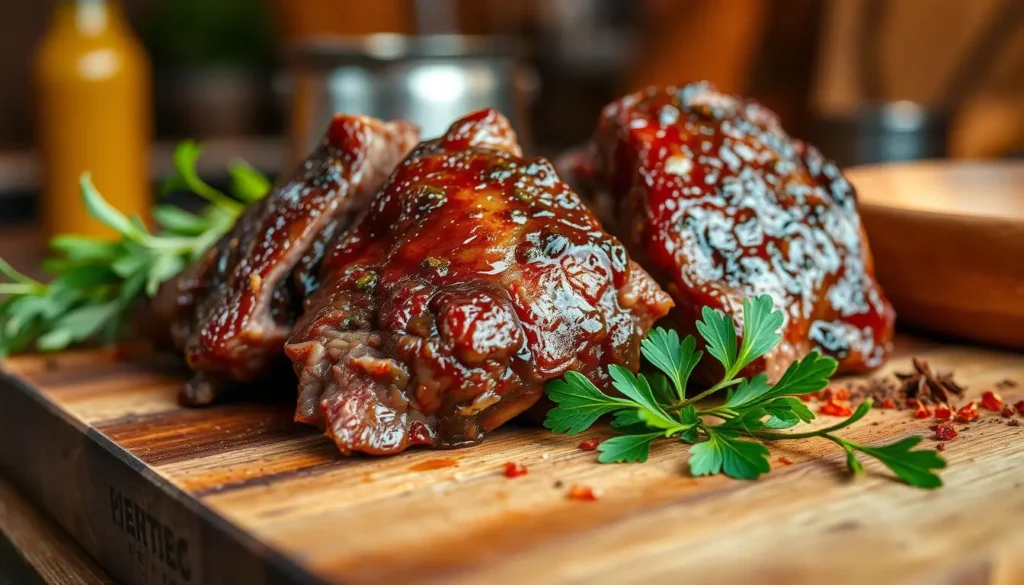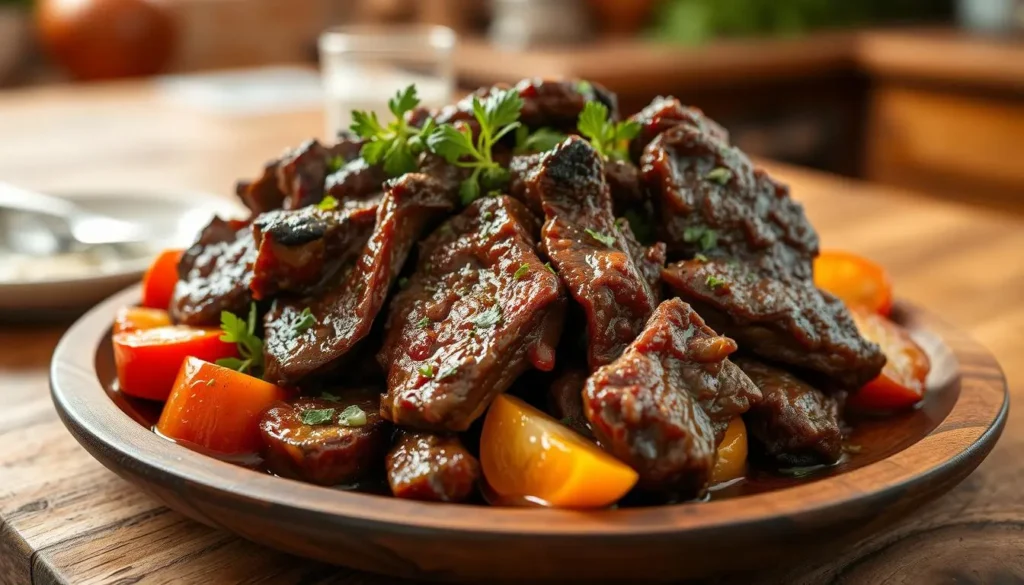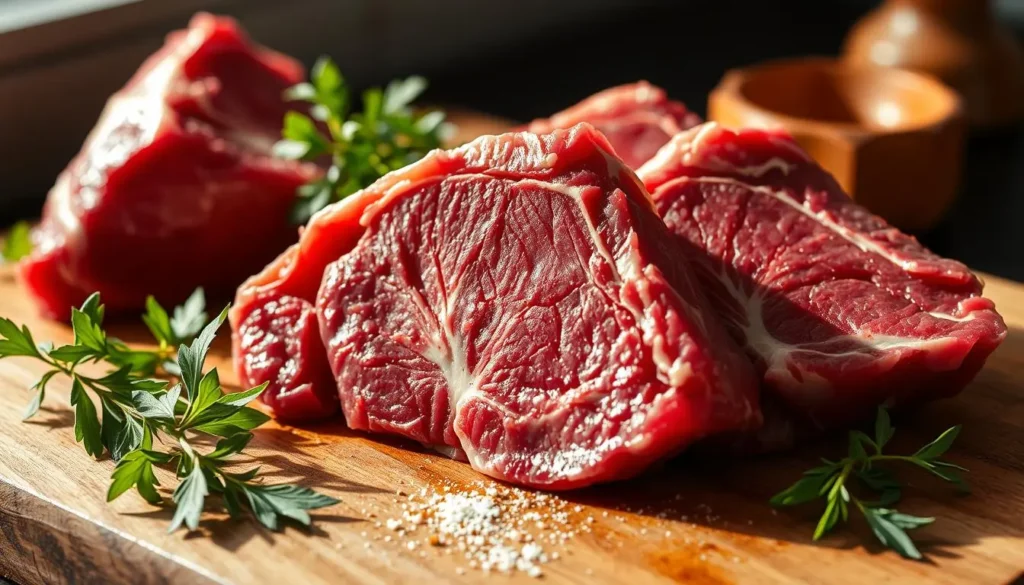What are Beef Cheeks Called in the USA? Exploring food, you might have seen beef cheeks becoming popular in the US. You might wonder, what do they call beef cheeks here? This question leads us on a journey to find out the names and terms for this meat. You’ll see why chefs and home cooks love beef cheeks so much.
Learning about beef cheeks in the USA is just the start. You’ll find out the different names used in different places. This knowledge will make you more confident in cooking with beef cheeks, whether you’re a pro or just starting out.
Key Takeaways
- You’ll learn about the different names and terminology used for beef cheeks in the USA.
- Understanding what beef cheeks are called in the USA will help you navigate the culinary world with confidence.
- Beef cheeks are gaining popularity in the United States due to their unique characteristics and uses.
- You’ll discover the various ways to prepare and cook beef cheeks.
- Knowing what beef cheeks are called in the USA will help you make informed decisions when shopping for this cut of meat.
- You’ll uncover the reasons behind the growing interest in beef cheeks among chefs and home cooks.

What Are Beef Cheeks Called in USA: Understanding the Terminology
When it comes to beef cheeks, the names can change in the United States. You might hear them called different things, based on where you are. The question of what are beef cheeks called in USA is common, and the answer varies by region.
In the USA, beef cheeks are often called cheek meat or beef cheek meat. But, different areas have their own names for this meat. For example, in some places, they’re called beef jowls or beef jaw meat.
Common American Names for Beef Cheeks
- Beef cheek meat
- Cheek meat
- Beef jowls
- Beef jaw meat
Knowing these names helps when you’re looking for beef cheeks at the butcher or supermarket. You can ask for them by their common names. Then, the butcher or store staff will know exactly what you want.
Regional Variations in Naming
There are interesting regional differences in naming beef cheeks. For example, in some Southern states, they’re called beef jaw meat. In other parts of the country, they’re known as cheek meat. These differences show the variety of beef cheeks in the USA and add to American culinary culture.
The Anatomy of Beef Cheeks and Their Characteristics
When you think about beef cheeks, you might ask, are beef cheeks good meat? Let’s look at what makes them special. Beef cheeks come from the cow’s face, specifically the masseter muscle. This muscle helps the cow chew, making it tough and full of connective tissue.
This connective tissue is what makes beef cheeks stand out. When cooked right, the collagen in it melts, making the meat tender and tasty. The texture of beef cheeks is rich and velvety, perfect for slow-cooked meals.
Some key traits of beef cheeks include:
- High collagen content, which contributes to tenderness when cooked
- Rich, beefy flavor profile
- Coarse texture, which becomes tender with slow cooking
In short, beef cheeks are a great choice for some dishes because of their unique qualities. They need special cooking to get tender, but it’s worth it. Knowing about beef cheeks helps you enjoy a delicious meal.
Nutritional Profile of Beef Cheeks
Are beef cheeks good meat? Yes, they are. Beef cheeks are full of nutrients, including lots of protein. This protein is important for building and fixing muscles. A 3-ounce serving of cooked beef cheeks has about 22 grams of protein.
Beef cheeks also have a good amount of fat, with 15 grams in a 3-ounce serving. This fat makes the meat tender and full of flavor. It also helps keep the meat moist while it’s cooking.
Key Nutrients in Beef Cheeks
- Protein: essential for muscle growth and repair
- Fat: contributes to flavor and tenderness
- Vitamins: such as vitamin B12 and niacin
- Minerals: including iron, zinc, and phosphorus
Beef cheeks are a mix of good nutrients. They add flavor and tenderness to any dish. So, are beef cheeks good meat? Absolutely, they are a tasty and healthy choice.
Why Beef Cheeks Are Gaining Popularity in American Cuisine
Are beef cheeks good meat? Yes, they are, thanks to their unique taste and texture. Chefs love them for these reasons. Beef cheeks are becoming more popular in American cooking because of a trend towards using the whole animal.
Beef cheeks are gaining fans for several reasons. People want to eat more sustainably. Using the whole animal means less waste and more creative dishes. Foodies and home cooks alike enjoy their rich flavor and tender texture.
Some of the key benefits of beef cheeks include:
- Rich, beefy flavor
- Tender, fall-apart texture
- Versatility in cooking methods
- Sustainable and responsible food choice
So, are beef cheeks good meat? Absolutely, and their popularity shows it. With more people looking for different meats, beef cheeks are becoming a favorite in American cooking. Whether you’re a pro chef or just starting out, beef cheeks are worth trying.
| Cut of Meat | Flavor Profile | Texture |
|---|---|---|
| Beef Cheeks | Rich, beefy | Tender, fall-apart |
| Brisket | Smoky, savory | Tough, chewy |
| Short Ribs | Meaty, umami | Fall-off-the-bone tender |
The True Cost of Beef Cheeks: Price Analysis
Wondering why is beef cheek so expensive? The price of beef cheeks changes based on several things. Knowing these can help you choose wisely when buying this meat.
The cost of beef cheeks goes up because of how easy it is to find, how much people want it, and how it’s processed. If you’re searching for a budget-friendly option, you might ask are beef cheeks a cheap cut? It really depends on where you are and the local market.
- Availability: Limited supply can drive up prices
- Demand: High demand, especially in upscale restaurants, can increase costs
- Processing requirements: More complex processing can lead to higher prices
Compared to other meats, beef cheeks are pretty affordable. But, prices can differ a lot based on the market and area. To find the best deal, it’s smart to compare prices at different places.
| Cut of Meat | Average Price per Pound |
|---|---|
| Beef Cheeks | $6-$8 |
| Brisket | $5-$7 |
| Chuck Roast | $4-$6 |
What Affects Beef Cheek Prices
Knowing what affects beef cheek prices can help you make better choices. Whether you’re on a tight budget or willing to spend more for quality, understanding the cost of beef cheeks can save you money.
Selecting Quality Beef Cheeks: A Buyer’s Guide
When looking for beef cheeks, you want the best. Look for beef cheeks that are rich red and firm. Check the packaging for damage or leaks to ensure freshness.
So, are beef cheeks good meat? Yes, they’re full of flavor and nutrients. Here’s what to look for in quality:
- Color: Choose beef cheeks with a deep red color for freshness and quality.
- Texture: Go for beef cheeks that feel firm. This means they’ll be tender and juicy.
- Freshness: Always check the packaging for damage or leaks. Pick beef cheeks with a recent packaging date.
You can buy beef cheeks at local butcher shops, specialty meat markets, or online. Brands like ButcherBox and Snake River Farms offer great quality beef cheeks for cooking.
Follow these tips to pick the best beef cheeks. This way, you’ll enjoy a tasty and healthy meal. Always handle and store beef cheeks safely for quality and food safety.

Essential Preparation Methods for Beef Cheeks
Preparing beef cheeks right is key to unlocking their rich flavor and tender texture. You’re about to cook braised beef cheeks. Start by trimming and cleaning the meat. Remove any extra fat or silverskin to ensure even cooking and prevent toughness.
Next, think about marinating techniques to boost the flavor of your beef cheeks. Dry rubs and wet marinades can complement the meat’s natural taste, making it even more tasty. For instance, a mix of olive oil, garlic, and herbs can add a rich flavor to your braised beef cheeks.
Preparation Steps
- Trim and clean the beef cheeks, removing excess fat and silverskin
- Marinate the meat using a dry rub or wet marinade to enhance flavor
- Bring the beef cheeks to room temperature before cooking to ensure even cooking
By following these essential preparation methods, you’ll be able to create a delicious dish using beef cheeks. Whether you’re making braised beef cheeks or another recipe, proper preparation is key to bringing out the best flavor and texture.
Remember to pat the meat dry before cooking to remove excess moisture and promote even browning. With these simple steps, you’ll be well on your way to creating a mouth-watering dish using beef cheeks.
| Preparation Method | Description |
|---|---|
| Trimming and Cleaning | Remove excess fat and silverskin from the beef cheeks |
| Marinating | Use a dry rub or wet marinade to enhance flavor |
| Pre-cooking Steps | Bring the meat to room temperature and pat it dry before cooking |
Best Cooking Methods for Tender Results
Cooking beef cheeks right is all about getting them tender and full of flavor. Slow-cooking, especially braising, is perfect for this cut. Braising breaks down the meat’s tough parts, making it tender and easy to shred.
To braise beef cheeks, first brown them in a pan. Then, cook them in liquid like stock or wine on low heat for hours. You can do this on the stovetop or in the oven. It’s easy and doesn’t require much attention. You can also use a slow cooker or Instant Pot for a quicker option.
Other methods like sous vide or pressure cooking also work well. They help keep the meat moist and flavorful, even when you’re in a hurry. Here’s how to cook beef cheeks with these methods:
How to Cook Beef Cheeks
- Use a sous vide machine to cook beef cheeks at a low temperature (around 130-140°F) for several hours.
- Use a pressure cooker to cook beef cheeks quickly, about 30-40 minutes.
- Use a slow cooker to cook beef cheeks on low heat for 8-10 hours.
Cooking beef cheeks low and slow is key. This method breaks down the meat’s tough parts. It makes the meat tender and delicious. With patience, you can make braised beef cheeks that everyone will love.
| Cooking Method | Cooking Time | Temperature |
|---|---|---|
| Braising | 2-3 hours | 300°F |
| Sous Vide | 2-3 hours | 130-140°F |
| Pressure Cooking | 30-40 minutes | High Pressure |
Popular American Recipes Using Beef Cheeks
Beef cheeks offer endless cooking possibilities. You can braise, slow cook, or make them in a fancy dish. They’re great for stews or fancy meals. Braising them in liquid like stock or wine tenderizes the meat and adds flavor.
Popular recipes include braised beef cheeks with red wine and mushrooms, beef cheek tacos with salsa and avocado, and beef cheek stew with veggies and bread. These dishes highlight beef cheeks’ rich taste and tender texture, making them a standout in any meal.
- Choose the right cut: Look for beef cheeks that are fresh and have a good balance of fat and lean meat.
- Use the right cooking liquid: Red wine, stock, and beer are all great options for braising beef cheeks.
- Don’t overcook: Beef cheeks can become tough if they are overcooked, so make sure to cook them until they are tender but still retain some texture.
By following these tips and trying out these recipes, you can make delicious dishes with beef cheeks. Whether you’re experienced or new to cooking, beef cheeks are a fantastic ingredient. Their rich flavor and tender texture will surely impress.
| Recipe | Ingredients | Cooking Time |
|---|---|---|
| Braised Beef Cheeks | Beef cheeks, red wine, mushrooms, onions | 2-3 hours |
| Beef Cheek Tacos | Beef cheeks, salsa, avocado, tortillas | 1-2 hours |
| Beef Cheek Stew | Beef cheeks, vegetables, crusty bread | 1-2 hours |

Conclusion: Making the Most of This Unique Cut
Beef cheeks are a special and tasty cut of meat. They are known as beef cheeks or “beef bacon” in some places. This versatile ingredient opens up many possibilities in cooking.
Beef cheeks are not just delicious; they’re also very nutritious. They are full of protein, vitamins, and minerals. Knowing how to choose, prepare, and cook them brings out their best.
The popularity of beef cheeks is rising in American cooking. They are affordable and easy to find. Now is a great time to try this underappreciated cut.
So, start using beef cheeks in your cooking. Try braising, slow-cooking, or adding them to your favorite dishes. With what you’ve learned, you’re ready to enjoy this unique and tasty meat.
FAQ
What are beef cheeks called in the USA?
In the USA, beef cheeks are known by several names. These include “beef cheek”, “ox cheek”, “cheek meat”, and “jowl”. The name used can vary by region and butcher shop.
What are the common American names for beef cheeks?
In America, beef cheeks are known as “beef cheek”, “ox cheek”, “cheek meat”, and “jowl”. These names are used all over the country, with some slight regional differences.
How do the names for beef cheeks differ across regions in the USA?
In the Midwest, they’re called “ox cheek”. In the Northeast, it’s “cheek meat”. The South uses “jowl” and “beef cheek” together.
What terminology do butcher shops use for beef cheeks?
Butcher shops label them as “beef cheek”, “ox cheek”, or just “cheek”. Some might say “facial meat” or “jowl meat” for more detail.
Are beef cheeks considered good meat?
Yes, they’re seen as high-quality and tasty. They’re best slow-cooked, which makes them tender and flavorful.
What are the nutritional benefits of beef cheeks?
Beef cheeks are packed with protein, which is good for muscles. They also have fat for flavor and minerals like iron and zinc.
Why are beef cheeks becoming more popular in American cuisine?
Beef cheeks are becoming more popular in American cooking. This is because of a trend for diverse meats, unique flavors, and nose-to-tail eating. Chefs and home cooks love their taste and texture.
Why are beef cheeks considered an expensive cut of meat?
They’re pricey because they’re in demand and hard to find. Their flavor and tenderness make them worth the cost.
How can you select quality beef cheeks when shopping?
Look for beef cheeks that are deep red and firm. Avoid any that look dry or smell bad. Buy from a trusted butcher or meat market for the best quality.
What are the best cooking methods for tender beef cheeks?
Slow-cooking, like braising, is best for tender beef cheeks. Braising sears the meat then cooks it slowly. Sous vide and pressure cooking also work well.
What are some popular American recipes featuring beef cheeks?
Popular recipes include braised beef cheeks, slow cooker stew, and dishes like beef cheek tacos. These recipes highlight the meat’s unique flavor and texture.

